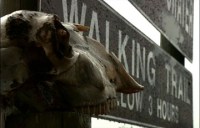Wolf Creek
 I know Wolf Creek doesn’t seem like an appropriate destination for cultured – and sensible! – people such as you and me, but allow me to make a case for visiting this remote area of the Australian Outback in your cinematic travels.
I know Wolf Creek doesn’t seem like an appropriate destination for cultured – and sensible! – people such as you and me, but allow me to make a case for visiting this remote area of the Australian Outback in your cinematic travels.
Please ignore the advisories about missing people, torture, and maniacal laughter. (After all, who among us hasn’t crucified someone when we’ve been unkindly – and unfairly! – compared to Crocodile Dundee?) Instead, indulge me for a few minutes while I detail why Wolf Creek isn’t such a bad place to visit.
- A card at the outset offers some statistics about missing people. Consider what the movie might be like without it. Notice how virtually nothing of any importance happens in the first hour. Pay particular attention to how those framing titles make you leery of everything and everybody, and how your eagerness and anxiety to get to the good parts already! represent writer/director Greg McLean’s triumph in creating anticipation and suspense. Your impatience is a testament to your bloodlust, not his.
- Stop to marvel at those first 60 minutes, or (more accurately) what they accomplish in spite of themselves. Is it character development? Is it a poor attempt at character development? Or is it a demonstration that the mere act of spending an hour with the three relatively boring, relatively normal protagonists creates a bond that leads to a rooting interest in their survival? At least one critic chose the middle option (see the post’s first comment):
“I found them underdeveloped, and just because they get a lot of screen time wandering around doing nothing doesn’t mean we gain any insight into their hearts and souls before they get killed off.”
Yet I think that’s the point. What makes the movie work is that the characters don’t operate as literary creations but as people. That they aren’t colorful or dynamic or singular makes them easy to relate to. The balance here is between anonymity (a vessel for projection) and sympathy (real enough to be considered human).
- Beyond being nearly experimental in the way he withholds horror, McLean is daring with his point of view. Once the action gets going, we mostly spend time with our protagonists serially, not knowing what has become of the others. This strategy, like the opening text in concert with the uneventful first hour, is an exercise in discipline, in denying viewers what we know they want.
- See Saw. Wolf Creek would probably be easier to dismiss if it weren’t so clearly more artful and rigorous than the cheap, easy, and wildly successful Saw series – the primary forebear of today’s spate of torture-porn movies. The major difference is that while Saw is drawn mostly from the convoluted and borderline-silly moralistic and masochistic elements of Se7en, Wolf Creek is based in something far more random and therefore far more horrifying.
- Wolf Creek knows its (most obvious) movie precedent. Aside from its direct, possibly plot-propelling Crocodile Dundee reference, Wolf Creek employs the social context that gives The Texas Chain Saw Massacre its political dimension. Meat-packing automation left the Texas Sawyers jobless, while poison put Wolf Creek’s antagonist out of business.
- It also knows Australian cinema. The watches and automobile that stop working at an Australian geologic phenomenon? Straight from Peter Weir’s Picnic at Hanging Rock. And beyond that subtle reference, the movie clearly draws from Weir’s constant theme of dislocation – protagonists out of their natural settings.
- If Wolf Creek looks too professional in terms of its cinematography, the use of hand-held cameras gives it a documentary quality to undermine the effect. The intentionally rough texture lends it the same edge that underpins The Texas Chain Saw Massacre.
- Yes, Wolf Creek is a little too well-signed. Two late expository bits – one involving newspaper clippings, the other involving video cameras – are unnecessary and obvious. The information offered in the former is conveyed more effectively later, while the key bit revealed with the latter would be much more fun if audiences were able to discover it on their own by re-watching the movie. In both cases, it’s clear that McLean doesn’t trust himself or his audience enough. Yet the imperfect is often more charming than the perfect – a reminder that the filmmakers are human, too – and these are no more than minor hiccups.
- Cassandra Magrath, Kestie Morassi, and Nathan Phillips, as the three carefree young tourists, are appealing and genuine in roles that are typically barely performed in movies of this ilk. They certainly don’t seem like they’re acting in such a disreputable genre.
- As your tormentor, John Jarratt chews up and spits out scenery with the best horror-movie villains, yet he’s able to maintain his (and the movie’s) menace. His carefully calibrated portrayal, with just a hint of doubt-inducing harmlessness, both mocks and respects his character, convincingly tapping into his lurid ridiculousness and a grounded evil.
- Wolf Creek gave me a nightmare. For a terror/horror movie, there’s no better recommendation than that.

